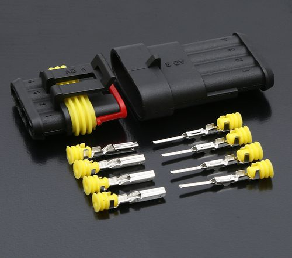Unveiling the Role of Automotive Low-Voltage Connector Terminals in Intelligent Networking.
- Home
- Unveiling the Role of Automotive Low-Voltage Connector Terminals in Intelligent Networking.

Unveiling the Role of Automotive Low-Voltage Connector Terminals in Intelligent Networking.
The role of automotive low-voltage connector terminals in intelligent networking is pivotal for the efficient operation of modern vehicles. These connectors serve as the physical interface for electrical connections between various vehicle components, facilitating the exchange of data and power.
Data Transmission: Low-voltage connector terminals enable the transmission of data between different electronic control units (ECUs) within the vehicle. This includes communication between the engine control unit, transmission control unit, infotainment system, safety systems, and other onboard devices. By facilitating seamless data exchange, these connectors contribute to the integration of intelligent networking features such as advanced driver assistance systems (ADAS), vehicle-to-vehicle (V2V) communication, and vehicle-to-infrastructure (V2I) communication.
Power Distribution: In addition to data transmission, automotive low-voltage connectors play a crucial role in power distribution throughout the vehicle. They ensure that electrical power from the battery or alternator reaches various components, such as sensors, actuators, pumps, and motors. This is essential for the proper functioning of electronic systems that control vital vehicle functions, including propulsion, braking, steering, and comfort features.
Integration of Advanced Technologies: As vehicles become increasingly connected and autonomous, the demand for advanced technologies continues to rise. Low-voltage connector terminals facilitate the integration of these technologies by providing standardized interfaces for connecting sensors, cameras, LiDAR systems, radar units, and other components essential for autonomous driving and intelligent networking.
Reliability and Durability: Automotive low-voltage connector terminals must meet stringent reliability and durability standards due to the harsh operating conditions encountered in automotive environments. They must withstand exposure to temperature extremes, moisture, vibration, and mechanical stress while maintaining secure electrical connections. Additionally, connectors designed for intelligent networking applications must support high-speed data transmission and comply with industry standards such as CAN (Controller Area Network), LIN (Local Interconnect Network), Flex Ray, and Ethernet.
Scalability and Future-Proofing: As automotive technology continues to evolve rapidly, low-voltage connector terminals must be scalable and adaptable to support future innovations. Manufacturers must design connectors that accommodate increasing data bandwidth requirements, higher power demands, and emerging communication protocols. By investing in versatile connector solutions, automakers can future-proof their vehicles and ensure compatibility with upcoming advancements in intelligent networking.
In summary, automotive low-voltage connector terminals play a crucial role in enabling intelligent networking features in modern vehicles. From facilitating data transmission and power distribution to integrating advanced technologies and ensuring reliability, these connectors are essential components that underpin the functionality and connectivity of next-generation automobiles.

